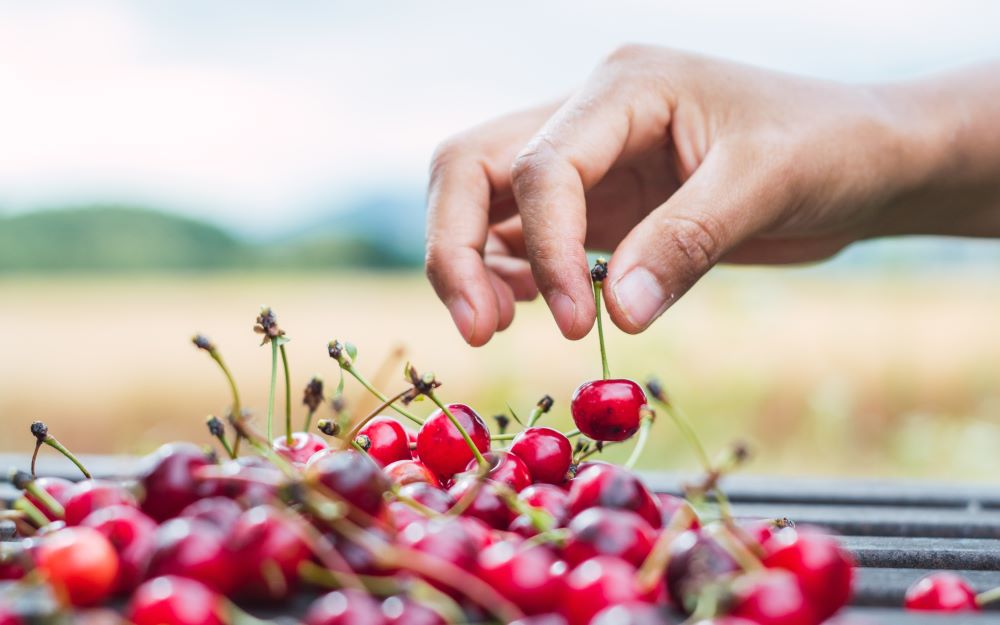Antioxidants play a key role in protecting our cells from oxidative stress and contribute significantly to our health. A particularly valuable source of these protective compounds is tart cherries , especially the Montmorency variety. In this article, you'll learn why tart cherries are so rich in antioxidants, what benefits they offer, and how to incorporate them into your diet.
The most important things in brief
Antioxidants are compounds that protect cells from oxidative stress and thus contribute to maintaining health
The most common natural antioxidants include vitamins and polyphenols
Sour cherries are fruits with a particularly high amount of antioxidants
The Montmorency sour cherry is particularly valuable because it contains the highest levels of polyphenols and melatonin
What are antioxidants?
Antioxidants play a crucial role in protecting cells from oxidative damage . The term "antioxidant" literally means "against oxidation." Antioxidants block the oxidation process by neutralizing free radicals. They can donate electrons to free radicals, thus interrupting their destructive chain reactions. Although they become radicals themselves after donating electrons, they are stable enough not to cause further damage.
The human body has a complex antioxidant defense system that produces both endogenous antioxidants and has the ability to extract antioxidant compounds from food. These compounds are found in a wide variety of foods, including fruits, vegetables, seeds, nuts, and oils. The best-known antioxidants include vitamin E, vitamin C, beta-carotene, polyphenols , and trace elements such as selenium . In addition to natural antioxidants, there are also synthetic ones. These are often added to foods to extend shelf life and prevent browning. The most commonly used synthetic antioxidants are butylhydroxytoluene (BHT) and butylhydroxyanisole (BHA). However, in excessive amounts, synthetic antioxidants can have potentially harmful effects (1).
What are oxidants?
The most common oxidants in the human body are so-called free radicals. These are atoms, molecules, or ions that are unstable and reactive towards chemical reactions due to unpaired electrons. An unpaired electron in free radicals causes them to accept electrons from other substances to stabilize themselves. However, this process creates another free radical, resulting in a chain reaction. Free radicals can arise from oxygen, nitrogen, and sulfur molecules. These molecules belong to a group of compounds called reactive oxygen species (ROS) (1).
Excessive amounts of ROS can cause oxidative stress , which can damage cells. ROS attack nucleic acids, proteins, and fatty acids. Under normal conditions, the body can use enzymes to keep ROS levels low to maintain cellular balance. However, under stressful conditions or when cellular function is disrupted, ROS levels increase , which can cause significant damage. If oxidative stress persists, it can cause various conditions and diseases. Factors that contribute to oxidative stress include poor diet and smoking (1, 2).
What are polyphenols?
Polyphenols are secondary plant compounds that occur naturally in fruits, vegetables, and grains. They are divided into complex groups of over 10,000 substances, depending on the number of their ring structures and hydroxyl groups. Plants produce polyphenols to protect themselves from harmful factors such as free radicals, UV radiation, and pests.
Polyphenols were once considered unimportant for health. However, in recent years, interest in studying phenolic compounds has increased because they have been linked to antioxidant properties (3).
Polyphenols are classified into four major groups: flavonoids, stilbenes, phenolic acids, and lignans , which form the basis for further subdivision of polyphenols. Flavonoids represent the most widely studied group and can be divided into several subgroups: flavan-3-ols, flavonols, isoflavones, flavanones, and anthocyanins (4).
Fig. 1: Classification of polyphenols (4)

What antioxidants are contained in sour cherries?
Sour cherries are particularly rich in antioxidants. In particular, sour cherries contain a large amount of anthocyanins . This polyphenol group is responsible for the red-blue color of many fruits and vegetables. To date , more than 700 different anthocyanin structures have been identified in plants (5).
Sour cherries contain the following polyphenols: anthocyanins such as cyanidin-3-glucoside, cyanidin-3-rutinoside, cyanidin-3-sophoroside, pelargonidin-3-glucoside, pelargonidin-3-rutinoside, and 3-glucoside and peonidin-3-rutinoside. Phenolic acids include hydroxycinnamic acids such as neochlorogenic acid and p-coumaroylquinic acid, as well as flavonols and flavan-3-ols such as catechin, epicatechin, quercetin-3-glucoside, quercetin-3-rutinoside, and kaempferol-3-rutinoside.
In addition to polyphenols, sour cherries contain numerous vitamins that are also known for their antioxidant properties. These include vitamin C, vitamin E, and beta-carotene (6).
A special feature of sour cherries is that they contain the antioxidant melatonin like hardly any other fruit. Melatonin is a hormone produced by the body that regulates the sleep-wake cycle and has also been detected in plants. There , melatonin acts as a radical scavenger and is involved in what is known as photoperiodism . This term describes the dependence of plant metabolism on the duration of sunlight. Consuming sour cherries can therefore increase the body's melatonin levels and support its hormonal functions (7).

Are sour cherries a good source of antioxidants?
Blando et al. measured the antioxidant capacity of tart cherries using the ORAC (Oxygen Radical Absorbance Capacity) test. This test evaluates how well ROS can be neutralized. The values are expressed as Trolox equivalents in micromoles per 100 g of fresh fruit. Tart cherries have values of 1145 to 2592 µmol TE/100 g, indicating a high antioxidant capacity . These values are comparable to those of strawberries, for example, but significantly higher than those found in apples or kiwis (8).
Studies have also shown that certain polyphenols, particularly anthocyanins and hydroxycinnamic acids, in tart cherries exhibit stronger antioxidant activity than comparable compounds in other fruits. Compared to berries such as blackberries, raspberries, blueberries, and strawberries, the polyphenols found in tart cherries exhibit significantly stronger antioxidant activity.
It's also worth mentioning that, due to their sour taste, sour cherries are usually consumed in processed form compared to sweet cherries. They are available in powder, juice, or juice concentrate, canned in jars, or frozen. This offers the advantage that sour cherries can be consumed not only seasonally but also year-round . Even after processing, most of the anthocyanins are retained. However, products with added sugar contain lower amounts of polyphenols (6).
Among the products that contain the most nutrients are tart cherry juice concentrates and capsules. Juice concentrates, in particular, are closest to the original form of the fruit and contain the majority of the original spectrum of phytochemicals . This was demonstrated in a study comparing various tart cherry products. The highest amount of antioxidants was found in tart cherry juice compared to frozen, canned, and dried tart cherries (9).




















Leave a comment
This site is protected by hCaptcha and the hCaptcha Privacy Policy and Terms of Service apply.